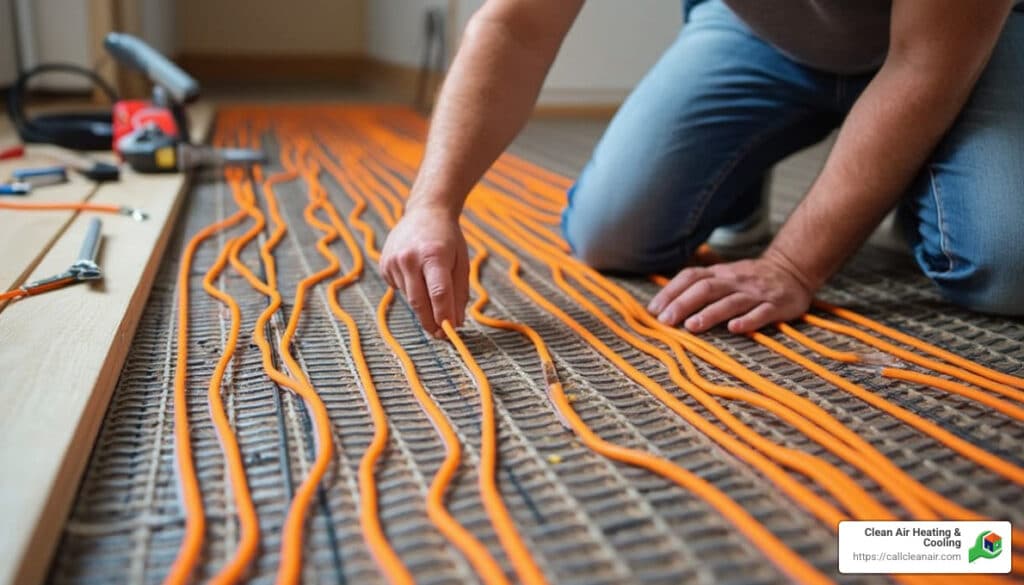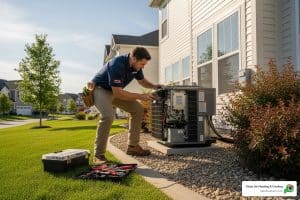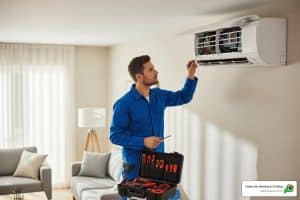Radiant floor heating maintenance is essential to ensure your heating system runs smoothly and efficiently, offering consistent comfort all year round. If you’re exploring radiant floor heating options, knowing the essentials of maintaining such systems can save you from future headaches. Whether you have electric radiant heating or water-based heating, regular checks can guarantee optimal performance. Here’s what you need to remember:
- Electric Radiant Heating: Generally requires minimal upkeep. Once properly installed, it seldom needs attention.
- Water-Based Heating: Needs periodic servicing to check system pressure, water color, and remove excess air to prevent potential issues.
Taking these steps can preserve the efficiency and longevity of your radiant floor heating system.
I am Colin Matei, Owner and President of Clean Air Heating & Cooling. With experience in HVAC services, I’m committed to providing clear guidance on radiant floor heating maintenance for residents in Northwest Washington. Transitioning from the basics to the specifics of maintaining your radiant floor heating will be our next step.

Key radiant floor heating maintenance vocabulary:
– Energy efficient floor heating
– Floor heating installation guide
– Floor heating pros and cons
Types of Radiant Floor Heating Systems
When considering radiant floor heating, understand the different types available. This knowledge helps you make informed decisions about installation and maintenance. Let’s explore the main types of radiant floor heating systems: electric radiant heating, water-based heating, and hydronic systems.
Electric Radiant Heating
Electric radiant heating systems are straightforward and efficient. They use electric wires to produce heat, which then radiates through your floors. This type of system is often installed using heating mats or cables.
- Heating Mats: These come with pre-attached wires that roll out onto the subfloor. They’re ideal for regular-shaped rooms.
- Cable Systems: Offer more flexibility in installation, allowing for custom layouts in irregular spaces.
Electric systems are known for their low maintenance requirements. Once installed, they usually don’t need much attention, making them a hassle-free option for many homeowners.
Water-Based Heating
Water-based heating systems, also known as wet floor heating, use heated water to warm your floors. This system involves a network of pipes laid beneath the floor surface. A boiler or heat pump heats the water, which circulates through these pipes, providing warmth.
- Hydronic Systems: A popular choice within water-based heating. They are versatile and can use various energy sources, including solar, gas, or oil.
These systems are more complex than electric ones and require regular maintenance. Checking the system pressure, inspecting water color, and removing excess air are crucial tasks to keep them running efficiently.
Hydronic Systems
Hydronic systems are a subset of water-based heating and are particularly favored for their efficiency and cost-effectiveness. They can heat large spaces evenly and use hot water circulated through a series of tubes.
- Materials: Modern hydronic systems use durable materials like cross-linked polyethylene tubing, which prevents corrosion and extends system life.
These systems are often integrated into new constructions or major renovations, allowing them to be embedded within concrete or attached to subfloors. While they offer significant long-term benefits, they do require periodic professional inspections to ensure optimal performance.
Understanding these types of radiant floor heating systems helps in selecting the best option for your home. Each type has its own set of advantages and maintenance requirements, ensuring you get the most out of your investment.
Radiant Floor Heating Maintenance
Maintaining your radiant floor heating system is crucial for ensuring it works efficiently and lasts for years. Let’s explore the maintenance needs for both electric radiant heating and water-based heating systems.
Electric Radiant Heating Maintenance
Electric radiant heating systems are known for their minimal maintenance requirements. Once installed, these systems typically run smoothly without much intervention. However, there are a few simple checks you can perform to keep your system in top shape:
- Thermostat Recalibration: It’s essential to periodically check and recalibrate your thermostat. This ensures it’s accurately reading and maintaining the desired temperature. A well-calibrated thermostat can prevent unnecessary energy use and maintain comfort.
- Basic Inspections: While electric systems are largely maintenance-free, it’s wise to conduct a visual inspection occasionally. Look for any visible damage to wires or connections, especially after renovations or other work that might affect the flooring.

Water-Based Heating Maintenance
Water-based heating systems, often referred to as hydronic systems, require more attention than their electric counterparts. Regular maintenance helps prevent issues like leaks and ensures the system operates efficiently.
- System Pressure Checks: Regularly monitor the system pressure. A drop in pressure can indicate a leak or other issues. Ideally, pressure should remain within the manufacturer’s recommended range.
- Water Color Inspection: Check the color of the water circulating in the system. Discoloration can indicate corrosion or contamination. If the water appears dirty, it might be time for a system flush.
- Air Removal: Over time, air can become trapped in the system, reducing efficiency. Bleeding the system to remove excess air ensures optimal heat distribution and prevents air locks.
- Leak Detection: Keep an eye out for any signs of leaks, such as damp spots on floors or unexplained drops in system pressure. Addressing leaks promptly prevents further damage and maintains system efficiency.
Regular inspections and maintenance tasks like these can significantly extend the lifespan of your water-based heating system, ensuring consistent warmth and comfort.
By understanding and performing these maintenance tasks, you can enjoy the benefits of radiant floor heating without unexpected disruptions. Next, we’ll dig into common issues and repairs associated with these systems.
Common Issues and Repairs
Radiant floor heating systems, whether electric or water-based, can occasionally encounter issues that require attention. Here, we’ll walk through some common problems and how they can be addressed.
Mixing Valves
Mixing valves play a crucial role in water-based systems by regulating water temperature. If they malfunction, you might experience inconsistent heating or even damage to your flooring due to overheating.
Steps to Address Mixing Valve Issues:
- Check Temperature Settings: Ensure the valve is set to the correct temperature. An incorrect setting can cause heating issues.
- Inspect Thermostat Sensors: Faulty sensors can send wrong signals to the valve. Verify their accuracy.
- Professional Assessment: If settings and sensors are fine, contact a professional to inspect and possibly replace the valve.
Zone Valve Issues
Zone valves control the flow of water to different heating zones. When they fail, you may notice uneven heating or no heat in certain areas.
Steps to Address Zone Valve Issues:
- Check Transformer and Fuses: Ensure the transformer is working and fuses are intact. A blown fuse could be the culprit.
- Professional Help: If the transformer and fuses are not the issue, a technician should inspect the valves for any mechanical failures.
Leaks
Leaks are a significant concern, especially in water-based systems. They can cause water damage and reduce system efficiency.
Steps to Address Leaks:
- Spot Check for Dampness: Look for damp spots on floors that could indicate a leak.
- Monitor System Pressure: A sudden drop in pressure often signals a leak.
- Professional Repair: Leaks should be repaired by a professional to prevent further damage.
Air Locks
Air locks occur when air gets trapped in the system, obstructing water flow and causing uneven heating.
Steps to Address Air Locks:
- Bleed the System: Regularly bleeding the system can remove trapped air.
- Listen for Noises: Gurgling sounds may indicate air in the system.
- Routine Maintenance: Schedule regular maintenance to prevent air accumulation.
Damaged Panels or Tiles
Flooring materials can be damaged by excessive heat or improper installation.
Steps to Address Damaged Panels:
- Temperature Regulation: Ensure your system is not overheating, which can warp flooring.
- Visual Inspection: Regularly check for signs of wear or damage.
- Professional Assessment: If damage is found, consult a professional to evaluate and replace affected areas.
By understanding these common issues and having a plan for addressing them, you can keep your radiant floor heating system running smoothly. Next, we’ll explore the benefits of regular maintenance to help you get the most out of your system.
Benefits of Regular Maintenance
Regular radiant floor heating maintenance is key to open uping the full potential of your heating system. It ensures energy efficiency, system longevity, and cost savings.
Energy Efficiency
A well-maintained radiant floor heating system operates at peak efficiency. Dust, dirt, and wear can cause your system to work harder, consuming more energy. Imagine trying to run a marathon with a backpack full of rocks—your system feels the same way when it’s not maintained.
- Clean Components: Regular cleaning keeps your system free from debris that can hinder performance.
- Efficient Operation: An efficient system means lower energy bills and a greener home.
Longevity
Routine maintenance extends the life of your radiant floor heating system. Without it, small issues can snowball into major problems, leading to costly replacements.
- Early Problem Detection: Identifying and fixing minor issues early prevents them from becoming serious.
- Prolonged System Life: Well-maintained systems can last decades, saving you the hassle and expense of premature replacement.
Cost Savings
Investing time in maintaining your system saves money in the long run. It reduces the need for expensive repairs and lowers energy costs.
- Fewer Breakdowns: Regular checks reduce the likelihood of unexpected, costly repairs.
- Lower Energy Bills: Efficient systems consume less power, putting more money back in your pocket.
In summary, committing to regular maintenance not only keeps your home warm and cozy but also protects your investment. Next, we’ll tackle some frequently asked questions about maintaining radiant floor heating systems.
Frequently Asked Questions about Radiant Floor Heating Maintenance
Does radiant floor heating need regular maintenance?
Yes, radiant floor heating maintenance is essential, though the frequency and type depend on the system. Electric radiant heating systems require minimal upkeep. Once installed, they typically don’t need regular servicing unless issues arise, like a thermostat needing recalibration.
On the other hand, water-based heating systems demand more attention. Regular check-ups are crucial to ensure everything runs smoothly. Key tasks include system pressure checks, water color analysis, and air removal. These steps help prevent potential problems, ensuring your system operates efficiently.
How often should I check my radiant heating system?
Checking your radiant heating system at least once a year is a good rule of thumb. For electric systems, this might just mean a quick thermostat check. However, water-based systems need more detailed inspections:
- System Pressure: Ensure it stays within the recommended range.
- Water Quality: Look for discoloration, which signals the need for a flush and inhibitor re-dose.
- Air Removal: If you don’t have an automatic air vent, manually remove excess air to avoid air locks.
Regular inspections help catch small issues before they turn into costly repairs.
What are the signs of a malfunctioning radiant floor heating system?
Identifying issues early can save money and prevent discomfort. Here are some signs to watch for:
- Inconsistent Temperatures: If some areas are colder than others, there might be a problem with your system’s zoning or distribution.
- Strange Noises: Clanging, banging, or hissing sounds can indicate issues with pumps or valves.
- Leaks or Water Damage: Visible signs of water can mean a leak, which needs immediate attention.
- Increased Energy Bills: A sudden spike in costs might mean your system is working harder than it should.
If you notice any of these signs, it’s best to call a professional to investigate further.
By staying informed and proactive, you can ensure your radiant floor heating system remains a reliable source of comfort in your home. Next, we’ll dive into some common issues and repairs to be aware of.
Conclusion
At Clean Air Heating & Cooling, our mission is simple: to keep your home comfortable with high-quality service and best customer satisfaction. We understand that maintaining your radiant floor heating system is key to ensuring long-lasting comfort and efficiency.
By choosing us, you’re not just getting a service provider; you’re gaining a partner committed to your home’s comfort. We offer a 25% utility savings guarantee, reflecting our dedication to energy efficiency and cost savings for you. Our team, based in Northwest Washington, has earned over 480 5-star Google reviews, a testament to our reliability and expertise.
Radiant floor heating maintenance is crucial for both electric and water-based systems. Regular check-ups help prevent issues like leaks, air locks, and pressure imbalances, ensuring your system operates smoothly.
With our expert technicians, you can rest easy knowing that we will address any concerns swiftly and professionally. Our focus is on delivering prompt, high-quality service, so you can enjoy the warmth and comfort of your home without any stress.
If you’re ready to experience the benefits of a well-maintained radiant floor heating system, contact us today to schedule an inspection or consultation. Let us help you keep your home cozy and efficient for years to come.





